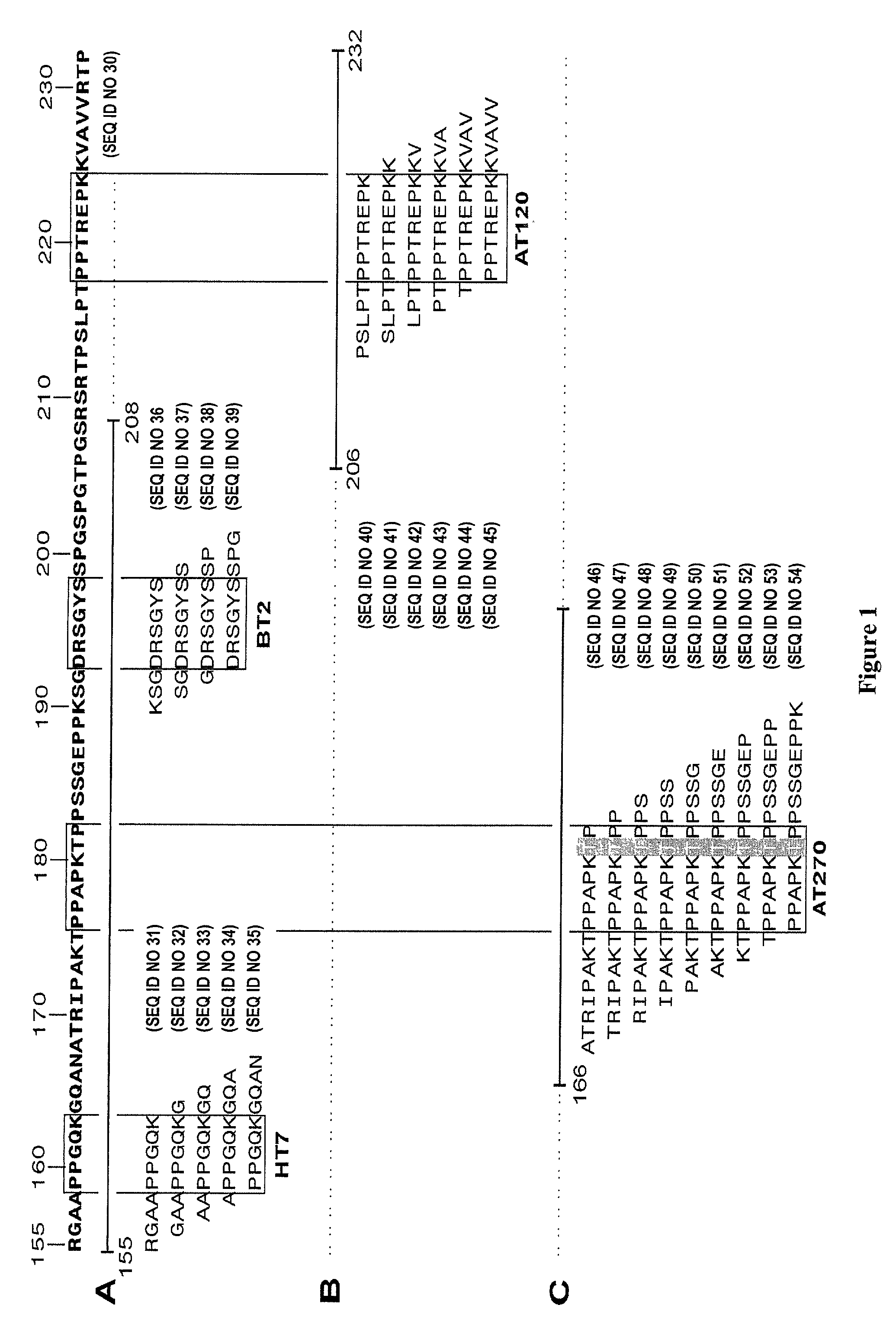Diagnosis of tauopathies
a tauopathies and diagnosis technology, applied in the field of diagnosis of tauopathies, can solve the problems of insufficient accuracy in the specific detection of tauopathies, difficulty in accurately determining the degree of phosphorylation of specific phospho-sites,
- Summary
- Abstract
- Description
- Claims
- Application Information
AI Technical Summary
Problems solved by technology
Method used
Image
Examples
example 1
[0110] Design of a Phospho-Peptide for Use in Standardization
[0111] 1.1 Synthesis of Tau and Tau-Derived Peptides
[0112] Two PCR primers (a primer containing the starting methionine codon -CATGGCTGAGCCCCGCCAGGAGTTCGAAGTGATGG (-1 to 34) (SEQ ID NO 4) and the reverse primer around the stop codon CCTGATCACAAACCCTGCTTGGCCAGGGAGGC (SEQ ID NO 5)) were used to amplify the smallest form from human tau into a P.sub.L-based expression system (Innogenetics, Gent, Belgium). The sequence of the PCR product was confirmed by sequencing. Changes were only observed at the third basepair in codons: at Pro 182 CAG instead of CAA, at Ala 227 GCG instead of GCA, and at Asn 251 AAC instead of AAT. All numbering with respect to the amino acid sequence refers to the longest tau isoform: hTau40 (Goedert et al., 1989). Deletion mutants were made based on constructing frameshift mutants by filling in the SacII site (amino acid position 154-155) and the PstI site (position 242-243).
[0113] Automated peptide synt...
example 2
[0128] Use of the Phospho-Peptide for Standardization in an Assay to Determine Phospho-Tau (181) in Patients with Alzheimer's Disease, Frontotemporal Dementia and / or Vascular Dementia
[0129] 2.1 Patients
[0130] Included in the study were 18 patients with FTD (age range 48-77 years), 60 patients with AD (age range possible 68-88 years; probable 58-90 years), 17 patients with subcortical artheriosclerotic encephalopathy (SAE; a putative form of vascular dementia) (age range 67-84 years), 15 patients with PD (age range 59-82 years), and 17 controls (age range 68-80 years). Their characteristics are summarized in table 2.
[0131] All patients included in the study had a clinical diagnosis of FTD, AD, SAE, PD and were consecutively recruited from prospective longitudinal studies on patients with dementia or PD. Clinical diagnoses were established and CSF sampling was performed. Then neurochemical analyses were performed at the Institute of Clinical Neuroscience, Sahlgrenska University Hospit...
example 3
[0153] Determination of the CSF-Phospho Tau (181) and CSF-Total Tau Level in Patients with Alzheimer's Disease Versus Patients with Acute Ischemic Stroke
[0154] 3.1 Patients
[0155] CSF-total tau and CSF-phospho-tau (181) were examined in longitudinal CSF samples from 22 patients, 16 men and 6 women, mean age.+-.SD, 65.7.+-.9.2 years, with an acute ischemic stroke. All patients were evaluated in a standardized way, as described previously (Tarkowski et al., 1999). When possible, CSF samples were collected on five occasions; at income day 0-1 (n=9), day 2-3 (n=18), day 7-9 (n=22), three weeks (n=21) and 3-5 months (n=21).
[0156] Also 54 patients with probable AD, 25 men and 29 women, mean age+SD, 73.3+7.4 years, and 17 healthy controls, 4 men and 13 women, mean age+SD, 68.6+7.5 years were studied. The mean age was significantly (p<0.05) higher in the AD than in the control group. The diagnosis of "probable AD" was made by exclusion, according to the NINCDS-ADRDA criteria (McKhann et al.,...
PUM
| Property | Measurement | Unit |
|---|---|---|
| Molar density | aaaaa | aaaaa |
| Molar density | aaaaa | aaaaa |
| Molar density | aaaaa | aaaaa |
Abstract
Description
Claims
Application Information
 Login to View More
Login to View More - R&D
- Intellectual Property
- Life Sciences
- Materials
- Tech Scout
- Unparalleled Data Quality
- Higher Quality Content
- 60% Fewer Hallucinations
Browse by: Latest US Patents, China's latest patents, Technical Efficacy Thesaurus, Application Domain, Technology Topic, Popular Technical Reports.
© 2025 PatSnap. All rights reserved.Legal|Privacy policy|Modern Slavery Act Transparency Statement|Sitemap|About US| Contact US: help@patsnap.com



